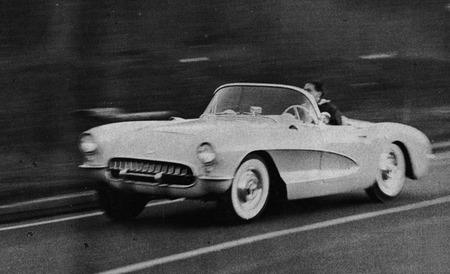The hard top is also easy to install, having two clamps at the front and three bolts and two locating dowels at the rear. It is well finished and padded, and provides unobstructed vision. Light and easy to transport, the top’s main fault is arbitrary sealing at the sides of the rear deck.
Instrument panel layout is identical to last year’s cars, and has many of the same faults. All the secondary instruments, including the tachometer, are very difficult to read at the bottom of the dash, even if you can take your eyes from the road long enough to find them. The speedometer is well-placed, but quick correlation between the numerals and the divisions is impossible, as they are on different planes. Dial lighting is very good, with rheostat control, and the interior lights are perfect for rallying, being placed under the cowl.
Other interior shortcomings are the dearth of storage space, save for the between-seat compartment, and a conflict between the heater and the passenger’s feet. The view forward is very impressive, and clever psychologically. The hood bulges, long fender lines, and cowl vents (which, incidentally, can easily be made functional for dry climates) combine to give an impression of great forcefulness. Vision over this snout is adequate, but not outstanding. The heater and defroster are well up to their jobs, and the only other irritant might be a very awkward and stiff interior door control.
In spite of numerous open car details, the passengers can be kept warm and dry, and can set their own climate at a literal touch of a button. I can imagine no greater contrast than between this and the forced exposure of the gutty old J2 Cadillac Allard, but the fact is that such an Allard in stock trim would be left behind at the quarter by this incredible Corvette! The figures speak eloquently for themselves, and with the lower 3.55:1 ratio things should happen even more rapidly. As a matter of fact, our speedometer was so very slow that it probably was geared for use with that ratio. Also, the engine was nothing like wound out at the top end, and the lower gearing would probably improve top speed by five to seven miles per hour.
Precision balancing after assembly may have accounted for the clean, smooth running of the engine, and its ability to rev freely to around 5500. For about the first half inch of throttle travel only the rear one of the two four-barrel carburetors is working to prevent over carburetion at low speeds. When the front quad cuts in the previously unobtrusive exhaust note sharpens and the car starts to move. When backing off at higher speeds there is a not unappealing rap from the duals. Idling is at 1000 rpm when the automatic choke is working and 600 rpm when warm, and the powerplant is tractable enough to lug down to a 12 mph in high.
Featuring special cooling and nine coils instead of the old diaphragm spring, the clutch took a lot of punishment without complaint. It is not easy to get a potent car off the mark with such very high gearing, and this component took the brunt of the effort without signs of heating or slippage. The gearbox wins similar praise for its well-chosen ratios and effective synchromesh. Shifting linkage is smooth and direct, the heavy-knobbed lever being spring-loaded to the right-hand side of the conventional “H” pattern. The synchro can be beaten by a very quick move from first to second, but the movement between the two top gears is impeccable. Synchromesh on low would be a useful boon, but a noiseless downshift can be made by double-clutching.
Due to the high ratios, the standard-shift Corvette is not really at home in town, and Powerglide might be better for urban use. Out on the road, though, as second gear takes over from first at around sixty and keeps the seat in your back ’til over a hundred, you learn what this car was made for. Cruising is effortless at 85 or 90, though with enough wind noise over the soft top to render the radio unintelligible.


Leave a Reply